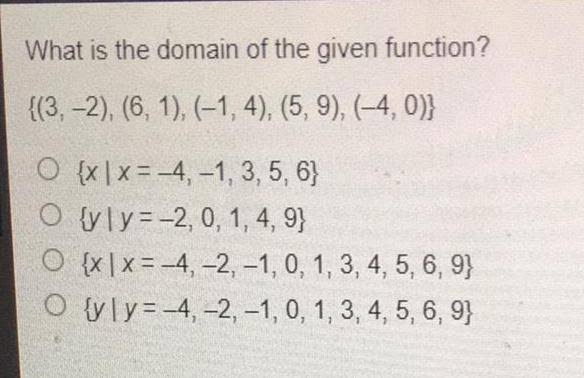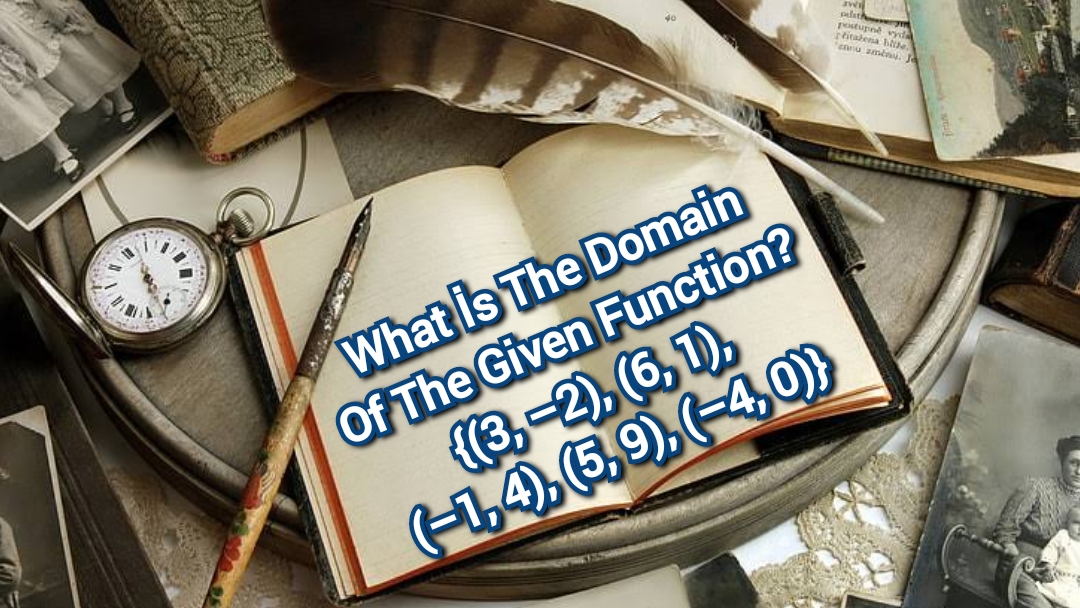What İs The Domain Of The Given Function? {(3, –2), (6, 1), (–1, 4), (5, 9), (–4, 0)} . All details, answers & video below.
What İs The Domain Of The Given Function? {(3, –2), (6, 1), (–1, 4), (5, 9), (–4, 0)}
What İs The Domain Of The Given Function? {(3, –2), (6, 1), (–1, 4), (5, 9), (–4, 0)}
- domain is the inputs
- range is outputs
- (x,y)
- x=input
- y=output
- just take the first numbers of every pair
- D={3,6,-1,5,-4}
- arrange it in order for fun or some reason
- D={-4,-1,3,5,6}
The domain of the given function {(3, –2), (6, 1), (–1, 4), (5, 9), (–4, 0)} is D={3,6,-1,5,-4}. This is further explained below.
What is a domain?
What İs The Domain Of The Given Function? {(3, –2), (6, 1), (–1, 4), (5, 9), (–4, 0)} Generally, All the possible inputs into a function are referred to as its “domain.” The span of possible results is known as the output range.
In conclusion, Given a function with values (3, –2), (6, 1), (–1, 4), (5, 9), (–4, 0), its domain is D=(3, –2), (–1, 4), (5, 9), (–4, 0).
Determine the area and range of the function F X equals three X ^2 + 6 X minus two. That is, the domain of the function, What is the set of all valid inputs or all valid X values for this function?
What İs The Domain Of The Given Function? {(3, –2), (6, 1), (–1, 4), (5, 9), (–4, 0)} . And I can take any real number, square it, multiply by three, then add six times that real number and subtract 2 from it. So, if we’re talking facts when we talk about any number, it’s essentially any number. So the domain, the set of valid inputs, the set of inputs on which this function is defined, are all real numbers. So the domain here is purely real numbers, all real numbers.
And for what you might say, aren’t all numbers real? You may or may not know that there is a class of numbers called imaginary numbers and complex numbers that are a little weird when you first learn them. But I won’t go into that right now. But most of the conventional numbers you know are part of the set of real numbers. Pretty much anything but complex numbers. You take any real number and put it in here, square it, multiply by 3, then add six and subtract 2. Now the range is at least the way we think about it.

What İs The Domain Of The Given Function? {(3, –2), (6, 1), (–1, 4), (5, 9), (–4, 0)} . The range is the set of possible possible outputs of this function. Or if we set y = F, Y equals F of X on a graph, that’s a set of all possible Y values. To get a taste of it, I’ll try to graph this function here. And if you have quadratic information and that’s the function here, it’s quadratic. You may already know that it has a parabolic shape and therefore its shape may look similar to this.
What İs The Domain Of The Given Function? {(3, –2), (6, 1), (–1, 4), (5, 9), (–4, 0)} . And it will actually look like this. It opens upwards. But other parabolas have similar shapes. And you see, when a parabola has this shape, it won’t take any value, it won’t take any value below its apex as it opens up, and it won’t take any value and it won’t take any value above it. vertex when opening downward. So let’s see. Let’s see if we can graph that and maybe get an idea of the peak. There are ways to calculate the vertex exactly, but let’s see how we can think about this problem. So I’m going to try some X&Y values.
What İs The Domain Of The Given Function? {(3, –2), (6, 1), (–1, 4), (5, 9), (–4, 0)} . There are other ways to calculate the vertex directly -. B/2. A is the formula for it. It directly subtracts from the quadratic formula you get by completing the square. But let’s try some X values and then see what F(X) equals. Let’s try. Here are the values we tried in the last few videos. What happens when x – equals 2? So F(X) is 3 times -, 2 squared, so 4 + 6 times -, 2, so.
What İs The Domain Of The Given Function? {(3, –2), (6, 1), (–1, 4), (5, 9), (–4, 0)} – 6 times -, 2, so minus 12 -, 2, so this is 12 -, 12, -, 2, so – is equal to 2. Now what happens when X equals -? one? So this is 3 times -, 1 squared, which is just minus, or +6 times -, 1, so minus six, then minus two, and then minus two. So this is 3 -, 6 -, 3 -. 2 is equal.
5 And this is actually the peak. And you know the formula for the corner is again -, b/2 a, so negative B. That’s the coefficient in this term. Right here – that’s 6 over 2 times this. Right here, 2 * 3 is twice 3. This is equal to 1. So this is the peak. But let’s continue from here. So what happens when X equals 0? These first two terms are zero. Only one -, 2 left.
What İs The Domain Of The Given Function? {(3, –2), (6, 1), (–1, 4), (5, 9), (–4, 0)}. When x is equal to positive one, and this is where you can see it’s the vertex. If you start to see the symmetry. If you go one top of the X vertex, F equals – 2. If you go 1X below the vertex, or below the X value of the vertex, F of X is still equal to -, 2. But let’s continue. We can try. Let’s make one more point here. We can try x equals 1. When x is equal to 1, 3 * 1 squared, which is 1.
So 3 * 1 + 6 * 1 which is just 6 -, 2. So this 9 – is equal to 2. Seven. And I think that’s enough points to give us a scaffolding of what this graph will look like, what the graph of the function will look like. So it will look something like this. Let me try my best to draw. So this X is equal to -, 2. Let me draw the whole axis. This X is equal to 1. This X is equal to.
This is X is 0, and this is X is equal to 1. And then when X is equal, we’re going from -, 2 to positive, or we have to go from -, 5 to plus 7. Y axis, Y axis. And then let’s move on to positive 71234.
What İs The Domain Of The Given Function? {(3, –2), (6, 1), (–1, 4), (5, 9), (–4, 0)} . I can continue. This is at Y, and we’re going to set Y to whatever the output of the function is. Y is equal to F(X) and this is one. So let’s draw the points. You have the point -, 2, minus 2. When X – 2, that’s the X-axis. When X – 2, when Y -, 2, Y -. 2. So this over there. So that’s the point.
That’s the -, 2, -, 2 point. Fair enough. When X – 1, when F of X – 5 When X – 1, F of X – 5. And we’ve already said that this is the vertex, and in a second you will see the symmetry around it. So that’s the point – 1, minus 5. And when X is 0, we have .0 minus 2 zeros – 2.
What İs The Domain Of The Given Function? {(3, –2), (6, 1), (–1, 4), (5, 9), (–4, 0)} . Y is equal to -, 2 or F of X – 2 or F of 0 – 2, so this is .0 negative 2. And finally X is equal to 1F 1 is 7, F of one 7, so that’s true. There are 1, 7, and it gives us a scaffolding of what this curve will look like. So I will try my best to draw them in order.
So it looks something like this and it keeps going in that direction, it keeps going in that direction. But I think you see the symmetry around the vertex, if you put a line here, the two sides are like mirror images of each other, you can flip them over and that’s how we know it’s a vertex and how we know it because it’s a parabola that opens up. I mean, there are formulas for the vertex, and there’s more than one way. What İs The Domain Of The Given Function? {(3, –2), (6, 1), (–1, 4), (5, 9), (–4, 0)}
- Find the volume of the figure the diameter of the base is 4 cm 2.5 cm
- The alter table statement conflicted with the foreign key constraint
- What İs The Domain Of The Square Root Function Graphed Below?
- Control The Openings Of The Gas Exchanging Pores İn The Dermal Tissue System
- Cross-cultural research stimulated by vygotsky’s sociocultural theory has shown that

 Number One Boats from USA. Boat Marketplace Group Network. All Boats & Yachts for Sale, Reviews, Specs, Prices, Craigslists.
Number One Boats from USA. Boat Marketplace Group Network. All Boats & Yachts for Sale, Reviews, Specs, Prices, Craigslists. 